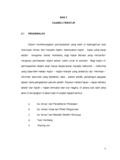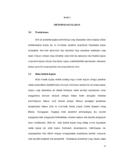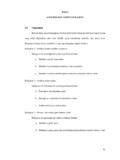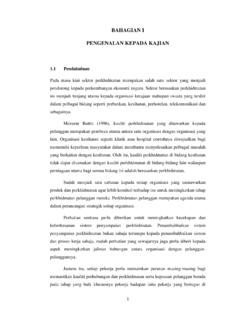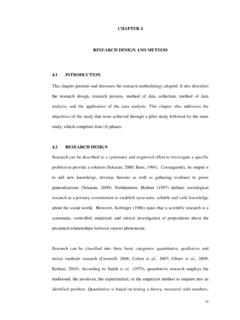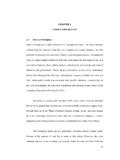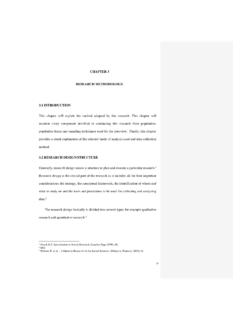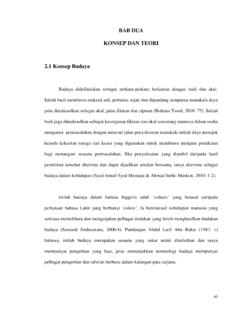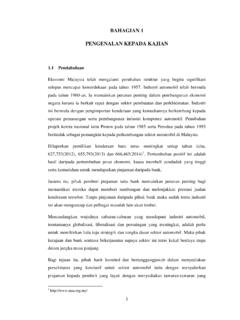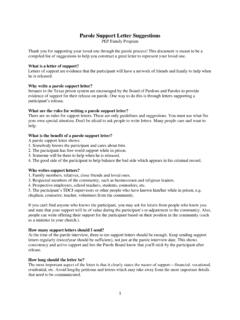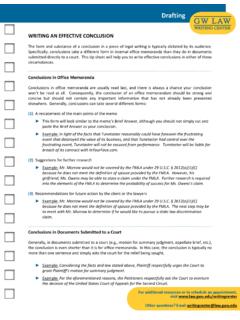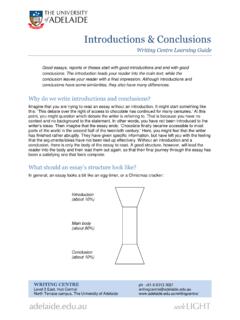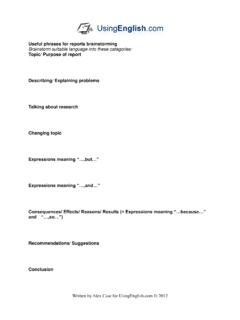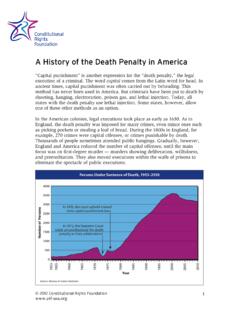Transcription of CHAPTER 5 CONCLUSION AND RECOMMENDATIONS 5.1 …
1 CHAPTER 5 CONCLUSION AND RECOMMENDATIONS . Introduction Base on the results obtained in CHAPTER 4, a discussion of the finding is presented in this CHAPTER . The findings from the study are used to discuss whether the proposed hypotheses are supported. All research questions will be answered subsequently and finally the achievement of research objectives are determined. Vendors are provided with managerial implications and RECOMMENDATIONS , to enable them to draft appropriate strategic in gaining consumers intention to purchase functional (healthy) food products.
2 Finally, the contributions of the study are discussed based on theoretical, methodological, practical approaches and end with suggestions for future research. Discussion of Results There are nine hypotheses proposed in this study. The nine hypotheses tested and all were found supported except for H1b, H1c, H1d, H1e, and H1f. The summary of the hypothesis testing results are show in Table There are five major research questions raised in this study. First question is. how consumers attitude influence on intention to purchase of the functional (healthy) foods in Malaysia.
3 One of the factors have been identified, namely a 77. benefit from using functional (healthy) food was found positively significant to the intention to purchase of functional (healthy) food products. However, from this examination of the others five dimensions are show not significant different in the intention to purchase of functional (healthy) food products. Nonetheless, only one dimension is in consumers attitude indentified have positively significant to the intention to purchase of functional (healthy) foods but this factor is consider important how consumers attitude influenced the intention to purchase of the functional (healthy) food products.
4 The second question is how does the subjective norm s influence on intention to purchase of functional (healthy) foods in Malaysia. The finding shows that subjective norm s is positively related to the intention to purchase functional (healthy) food products. The third question is how do the perceived behavioral control s influence on intention to purchase of functional (healthy) foods in Malaysia. The finding shows that perceived behavioral control s is positively related to the intention to purchase functional (healthy) food products. The forth question is does this intention to purchase lead the consumer to purchase functional (healthy) foods in Malaysia.
5 The outcome from this study shows there have positive significantly the intention to purchase lead to purchase of functional (healthy) food products. 78. Finally, the fifth question what are the important factors or attributes influence consumers intention to purchase of functional (healthy) foods in Malaysia. From the finding shows all the independent variables are the importance antecedents have influenced the intention to purchase of functional (healthy). food products, there are consist of attitude, subjective norm and perceived behavioral control.
6 Consumer's attitude toward of functional (healthy) foods According to the results obtained from SPSS analysis on the overall model (refer to Figure ), consumer s attitude of functional (healthy) foods is positively related to intention to purchase. The result shows consumer s attitude on intention to purchase of functional (healthy) foods is consistent with the previous the studies by (Lobb, Mazzocchi, & Traill, 2007; Mahon et al., 2006: Shepherd & Sparks, 1994; Sparks, Hedderley, & Shepherd, 1992) on the investigating food intention and consumption behavior which the consumer s own attitude is far more important than perceived social pressure or norm or perceived behavioural control.
7 There are six sub-constructs in this approach, namely, benefits from using functional (healthy) food products, confidence in functional (healthy) food products, necessity for functional (healthy) food products, functional (healthy) food products as medicine, functional (healthy) food products as part of health diet and absence of nutritional risk in for functional (healthy) food products. 79. However, separate examination of the six sub-constructs offers different insight, the results obtained from SPSS (refer to Table ) shows only one dimension was positively related to the intention to purchase functional (healthy) food products, namely benefits from using functional (healthy) food products.
8 The others five dimensions result from SPSS show that, were not significant related to the intention to purchase of functional (healthy) food products consist of confidence, necessity, as medicine, as part of health diet and absence of nutritional risk in for functional (healthy) food products. According to this study the result, the constructs of consumers attitude towards functional (healthy) foods which show benefits from using functional (healthy) food products, functional (healthy) food products as part of health diet and absence of nutritional risk in for functional (healthy) food products are consistent with the previous studies result by (Urala & Lahteenmaki, 2004).
9 However the results from this current study show confidence in functional (healthy) food products, necessity for functional (healthy) food products, functional (healthy) food products as medicine, ware not significant to the intention to purchase of functional (healthy) food products. There are five dimensions were found not significant different valid in our study however out these five dimensions there are two dimensions shows consistent with previous study by (Urala & Lahteenmaki, 2004). The others three dimensions show different were found to be not valid possibly due the fact that Malaysian respondents have different levels of education or educational background compared to their counterparts in western countries.
10 80. There is definitely a big difference in the point of view from the perception of consumers to functional (healthy) food products as evidenced in the different results generated from this study. Furthermore, the level of understanding of functional (healthy) foods for Malaysian consumers might be different compared to those in western countries. This might have led to different confidence levels of perception of functional (healthy) food products, which may result in the perception that there is no necessity for functional (healthy) food products in daily lifestyle.
